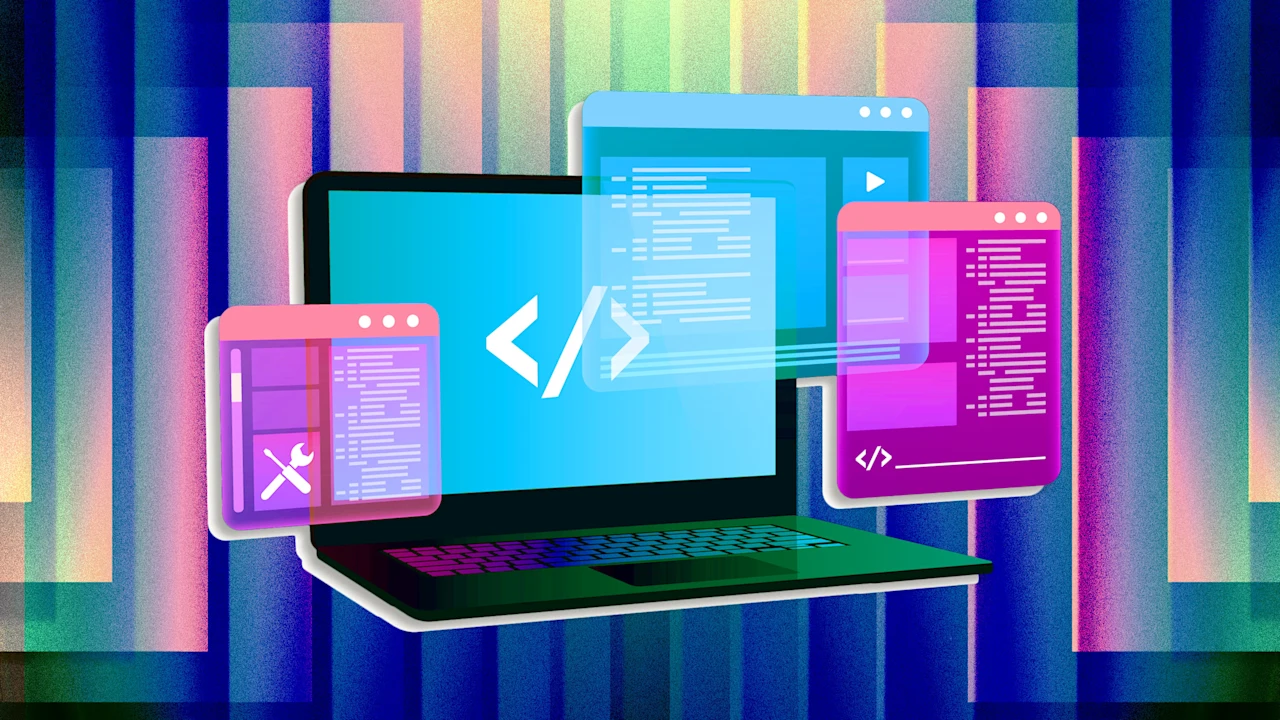Meet vibe coding’s nerdy but sane sibling

By now you’ve probably heard of “vibe coding”: creating software from scratch by prompting AI to generate the source code for you, instead of writing it yourself. The promise of spinning up real working apps from nothing but mushy human language is tantalizing—and companies such as Lovable and Replit have already ridden it to billion-dollar valuations.
There’s just one catch. For a wide swath of businesses with straightforward but mission-critical needs, vibe coding doesn’t actually work. AI still hallucinates, which means the code it generates is often sloppy and occasionally downright malicious. It can’t be trusted to be secure or consistent. No wonder that according to one major survey, 72% of professional software developers don’t use vibe coding tools on the job.
A New York-based startup called Aboard is pursuing a different approach. Call it “vibe product management.” Instead of using AI to jump right into generating code (and holding on for dear life), business leaders can work with “solution engineers” at Aboard who use AI to turbocharge the planning and discovery phases of enterprise software development—the lumbering, unsexy, but essential work of deciding what components to code and how to assemble them reliably.
If vibe coding is like asking a robot architect for a summer house and watching it start to pour concrete for a pool you may never have asked for, Aboard’s approach is all about making the robot focus on drawing up the blueprints first. It’s still faster, but also saner.
No AI code allowed
Aboard’s founders think that their plan-first, code-later approach is the future of AI-augmented software development, and they’re not alone: Amazon’s new coding tool, Kiro, is based on a similar concept. It’s all about coming to terms with a cruel fact: “You can freestyle a little widget or a to-do app, but you can’t freestyle large-scale software,” says Aboard CEO Rich Ziade.
His co-founder (and the company’s president) Paul Ford—who happens to be an internet-famous tech writer—puts it more bluntly: “You’re not going to get JPMorgan Chase to vibe code the next version of its banking app.”
Ford and Ziade would know. For most of the past decade, they ran a successful agency creating software for large companies such as Time Inc. and Goldman Sachs. “What people [in those organizations] want is safety and stability,” Ford says—not exactly AI’s strong suit. But after selling their agency in 2022 and watching AI capabilities accelerate in 2023 and 2024, Ford and Ziade wanted to find a way to make the bots work on their clients’ terms.
After one false start (with a consumer-facing app that was sort of like a ChatGPT-powered Pinterest board—“we lost our minds for a little bit,” Ziade says), Aboard officially launched earlier this summer at NY Tech Week.
Like Lovable and Replit, Aboard greets you with a text box and some snappy copy that invites you to type in a description of the “business app” you want the AI to build. (I asked it for a customer relationship management system—or CRM, in biz-speak—for my freelance writing business.) From there, a large language model-powered dialogue ensues, followed by several minutes of AI “thinking,” depending on what you asked for. Then a working preview of the app you asked for appears.
So far, so vibe code-y. Except it isn’t: “We do not let AI near the code,” Ford says. And what you receive isn’t a preview either—the result is a live working web app with a shareable URL, no broken buttons or missing features, and a real back end that’s prepopulated with placeholder data. When I gave them a similar prompt, neither Replit nor Lovable hit all those marks without throwing errors, running out of starter credits, or asking me for upsells.
Snapping the code into place
Granted, what I got from Aboard wasn’t exactly the Mona Lisa of CRMs. But its noncoding AI built a free, simple “first draft” business app that was markedly better than the ones I got from leading unicorn AI app-builders. How?
Under Aboard’s hood are dozens of specialized AI agents, just like the ones the vibe coding apps have. The difference is that instead of coding, Aboard’s bots whir away on assembling what the company calls a “Blueprint”: a strict, proprietary template that AI can use to plan what goes into an app.
Ziade likens this process to filling out Mad Libs—instead of giving the AI a pencil and a blank sheet of paper and saying “go,” it only gets a set of prestructured blanks to fill in. “But by narrowing what the AI can do,” he says, “we’re left with a much more predictable output that’s far, far more accurate and reliable than just letting it code.”
And the code itself? It’s pre-built and human-written, waiting for Aboard’s AI agents to click into place like Lego blocks according to the blueprint (using another proprietary process). That might sound like cheating, but for Ziade and Ford, it’s the whole point. “We’re not making video games with this thing—we’re focusing on enterprise or productivity software,” Ziade says. “And most of that software is based on pretty much the same building blocks.”
Those blocks—Ford says there are about 200—cover everything that a business web app needs to run on its own, from UI elements to database schemas. “It’s one integrated app, not a bunch of bits,” he says. Mine included a dashboard for displaying key metrics, a data-entry table for storing new leads, a kanban board for managing them, and a Slack-like sidebar for navigating it all.
This is why my first-draft CRM app worked right away: Aboard isn’t out to reinvent any wheels in the actual programming process. At least, not yet.
The client connection
Of course, if I were a 50-person company in the market for a bona fide enterprise application (instead of just one guy at a keyboard), the competent little CRM that Aboard’s website spun up for free wouldn’t really cut it. And Aboard doesn’t expect it to. Those insta-built apps are just a tease for what Ziade and Ford are actually selling: not a DIY vibe coding platform, but a new kind of software agency that combines the speed of AI with the bespoke service and reliable results of a human product team.
“Potential clients see the demo app and are, like, ‘Okay, this is promising,’” Ziade explains. “Then we say, ‘Hey, look what we did in a few minutes. Imagine if we had some real time to work together.’”
Once that relationship is established, Aboard’s product managers (or in their parlance, “solution engineers”) work directly with the business to generate more sophisticated versions of the software they actually need, using the AI blueprints to plan and assemble the “first drafts” and human engineers to polish and deliver the final product. (The company currently has around 30 employees.) But instead of funding the development process with large up-front fees—the usual business model for software agencies, including the one that Ford and Ziade used to run—Aboard charges a license fee for the finished product.
“Clients are expecting to have to pay a half million [dollars] up front just to see if the relationship’s going to work,” Ford says. “When we tell them, ‘You’ll get software, and then just pay us this amount each month,’ their eyes light up.”
Aboard is betting on businesses realizing that vibe coding platforms are throwing AI at the wrong problem. The first three to six months of any enterprise software project typically don’t involve much code at all. Instead, a ton of time and money is often spent aligning on what to code, then producing a first draft based on that specification just so “people can give feedback on what sucks,” Ford says.
This is exactly what Aboard aims its AI “vibes” at accelerating: It turns out that bots can assemble and iterate on those detailed, bespoke product specifications—the “blueprints”—very, very quickly, while snapping together non-buggy first drafts (using human-coded parts) quickly, too.
“The product we’re able to deliver is the destruction of, like, 20,000 meetings,” Ford says. It may not be finished software, instantly—that’s a fantasy—but it is the beginning of a journey toward finished software that doesn’t feel like a money pit or a death march.
“Everybody gets their thing”
Aboard’s pitch resonated with Grant Hunter, a senior vice president at Outsell, a specialty B2B research firm and a former product manager himself. Hunter needed to upgrade his company’s client portal, which still ran on an ancient FileMaker database. He says he “was tired of vibe coding as a concept” and that “when Aboard did their official launch at NY Tech Week, it clicked for me: Their whole idea of flipping this [process] on its head, using AI tools to do a lot of the up-front work, but with humans still being an ongoing part of it.”
Other software agencies he’d contacted about the project “were using tools like Lovable, but it was still the usual agency process: Here’s what we say we’re going to get done, and we think it’s going to take this amount of time,” Hunter says. “With Aboard, it was an ongoing partnership. In essence, I’m looking at them almost as an in-house product team.”
In other words, because Aboard’s human-steered AI agents can quickly plan the best solution for a company’s needs, instead of building (and rebuilding) code for software elements that might turn out to be extraneous or unreliable, small or midsize companies like Outsell can afford to commission the kind of white-glove, custom-fit software that was often only available to huge corporations. Ford has a catchphrase for it: “Everybody gets their thing.”
While Aboard only has a few clients so far—the company is not willing to name them yet, but they include a large insurance company and a prominent nonprofit—Ford and Ziade are confident that their model will catch on. Amazon is calling its version “spec-first development”—and although its Kiro tool also uses AI to write its code, it shares with Aboard the basic idea of keeping coding agents on a tight leash.
“Humans have to come back into the mix,” Ford says. “Why would you want them to be out of the mix? This is your treasured software, after all.”
What's Your Reaction?
 Like
0
Like
0
 Dislike
0
Dislike
0
 Love
0
Love
0
 Funny
0
Funny
0
 Angry
0
Angry
0
 Sad
0
Sad
0
 Wow
0
Wow
0













































![Chris Columbus Reveals He's Working on 'Gremlins 3' [Exclusive]](https://static1.moviewebimages.com/wordpress/wp-content/uploads/2025/08/still-from-gremlins.jpg?#)




!['Harry Potter' Director Chris Columbus Thinks HBO Reboot Can Adapt the Books Better [Exclusive]](https://static1.moviewebimages.com/wordpress/wp-content/uploads/2025/07/harry-potter-hbo-1.jpg?#)









































